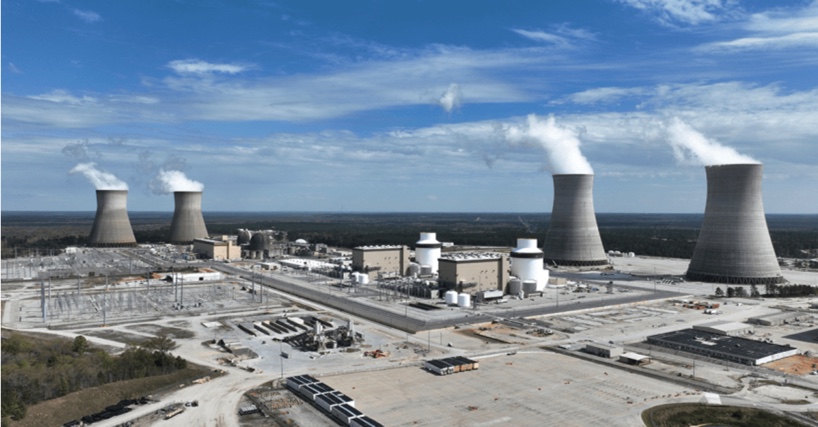“Developing countries are leading the movement toward nuclear generated electricity.”

Originally Published November 11, 2024, at America Out Loud NEWS
Hungry countries are pursuing reliable and emissions-free electricity from nuclear and other reliable sources, while wealthy countries focus on wind and solar for an unreliable and intermittent electricity supply.

Developing countries are spearheading the shift towards nuclear power in a world where reliable and sustainable electricity sources are crucial, while wealthier nations focus on wind and solar renewable electricity. The choice of nuclear power generation ahead of unreliable renewables is driven by their need for dependable, low emissions electricity to meet their growing demand for industrial, mining and agricultural goods producing growth.
Hungry countries are pursuing reliable and emissions-free electricity from nuclear and other reliable sources, while wealthy countries focus on wind and solar for an unreliable and intermittent electricity supply.
The Nuclear Landscape
Countries like France have embraced nuclear power since the 1960s, and have for 6 decades been safely producing electricity with 56 reactors that generate 361 billion kilowatt-hours of electricity annually. Nuclear accounts for 68% of the country’s annual electricity generation, the highest nuclear generation share in the world.
The French strategy includes building at least six new reactors by 2050, with construction starting in 2028 and commissioning by 2035. Nuclear energy also significantly contributes to France’s economy, supporting approximately 457,200 jobs directly and indirectly, apart from the millions employed by the industries its electricity supplies. France is also the largest net exporter of electricity in Europe.
The Department of Energy (DOE) advocates for nuclear power as a cost-effective and reliable source of electricity through various reactor designs, including large reactors for bulk electricity production, and Smaller Modular Reactors (SMRs) for flexible deployment. This has recently been proven in the newly updated Pathways to Commercial Liftoff report, where advanced nuclear (small and micro modular reactors) have been cited as having a differentiated value proposition that extends to thermal industrial heat required by the oil, coal and gas industries to produce the products that the world wants and needs.
The US Navy has a longstanding success with nuclear-powered vessels, emphasizing the safety and reliability of nuclear technology over decades. Nuclear power also stands out as one of the most cost-effective options for electricity generation.
Developing Countries Leading the Charge
Developing countries are leading the charge towards nuclear-generated electricity and include China, India, Korea, Indonesia, and South Africa amongst others. South Africa was the first in the world to start work on a commercial SMR in the early 2000s, which manifested into the Pebble Bed Modular Reactor (PBMR) project that was unfortunately politically halted in favour of green agendas in 2010. In 1959, the government started the development of a local nuclear industry. Subsequently, plans commenced in the following year for the construction of a research reactor, in collaboration with the US Atoms for Peace initiative.
South Africa is also leading the charge with SMR development, as nuclear expertise moved to the private sector after the PBMR project was shut down in 2010. South Africa is an exporter of nuclear expertise, as evidenced in the Barakah Nuclear facility build in the UAE where it had over 160 South African professionals working on the project that has successfully proven that nuclear power plants are both bankable and efficient.
There are numerous reasons why developing nations are leading the charge in embracing nuclear energy:
- Electricity poverty leaves people less likely to be responsible custodians of the environment, as people in poorer developing countries brutally survive in a world with inadequate access to goods, services and economic freedoms that are abundantly available in developed economies that were built on the products made from fossil fuels.
- In 2019, about 759 million people could not access electricity, nearly 75% of them (570 million) from Sub-Saharan Africa, which represents about half of the region’s population.
- In 2022 and 2023 some countries placed the phasing in or expansion of nuclear power at the centre of their strategies to reach climate policy objectives for electricity emissions that were reliable and safe, sparking a significant revival of global interest in nuclear energy and high-efficiency low-emission (HELE) coal energy. The IEA’s updated Net Zero Roadmap shows nuclear generated electricity more than doubling by 2050, complementing renewable deployment, and easing the pressure on critical mineral supply.
- The only operating Small Modular Reactor in operation in the world, including the Continental United States, is the High Temperature Gas-Cooled Reactor – Pebble-bed Module (HTR-PM) in Shidao Bay in China. The foundation for this technology stems from a collaboration with the Pebble Bed Modular Reactor program in South Africa.
- Based on economic research by Dr Rob Jeffrey, South Africa and many other poor developing economies need to join the movement toward “reliable and emissions-free electricity” from nuclear, mixed with High-efficiency Low emission (HELE) coal gas or oil energy as the only long-term solution for their sustained economic growth.
- These poor developing countries face the choice between a dark future of slow economic growth and rising unemployment or the potential of achieving high sustainable economic growth and achieving the only key objectives that matter, namely reducing poverty, unemployment and inequality.
- Sustainable economic growth can only be achieved through the rapid development of proven technologies with high-capacity factors like nuclear, (HELE) coal, gas and oil for affordable, reliable, continuous, and low emissions electricity that will benefit billions on this planet.
- It is imperative for countries, including the United States, to lead the way in adopting nuclear power to ensure electricity security and alleviate energy poverty effectively. The UK, European Union, Germany, Spain, California and South Australia are examples where the renewable transition to solar and wind has led to higher energy prices, slower growth and declines in their industrial and mining sectors.
- Access to electricity, infrastructure, and financial inclusion through economic development in a manner that respects both people and the environment is fundamental to human progress as a species. There is no other way to long-term prosperity.
- Activism without the measure of an outcome leads to entropy, which is the natural inclination of universal order towards chaos. “Renewables”, like wind and solar, only exist to generate intermittent electricity, as they CANNOT make any products or fuels!
- The demands for material to build wind and solar and EV batteries inflict substantial environmental degradation and humanity atrocities in China, Africa, Turkey, Democratic Republic of Congo, Argentina, Bolivia, and Chile. The materials for EV batteries and to. produce electricity from wind turbines and solar panels, require large-scale mining and refining of critical minerals and metals. The short life of renewables means toxic waste is an increasing problem with them
- Russia and China are currently leading the world in nuclear electricity generation and account for 70 per cent of new nuclear plants. Currently, there are about 440 nuclear power reactors operating in 32 countries. Today, about 60 reactors are under construction across the world. A further 110 are planned.
The Path Forward
The path is clear, there are no shortcuts and there is no skirting around the elephant in the room that Policymakers refuse to discuss-the path to reliable and sustainable electricity sources. Any sort of “Just Transition” needs to result in a proportionate increase in units of production that the World needs, to live to the standards that those imposing the standards would like to live. This is the only way to a true “Just energy transition”. One where the billions of impoverished people are given a light to shine whatever talent they have into the world. And for that, they need a spark.
Astonishingly, while hungry countries are pursuing reliable and emissions-free electricity from nuclear and low-emission technologies for their electricity supply from coal, oil and gas, the wealthier countries with ample goods and services produced by fossil fuel derivatives are focusing on continuously subsidizing wind and solar for occasional and unreliable electricity.
Please share this information with teachers, students, and friends to encourage Energy Literacy conversations at the family dinner table.
Click this Link to Sign up for Energy Literacy from Ronald Stein
_______
Follow DailyClout on Rumble! https://rumble.com/user/DailyClout
Please Support Our Sponsors
Birch Gold Group: “A Gold IRA from Birch Gold Group is the ultimate inflation hedge for your savings in uncertain times. Visit www.birchgold.com/dailyclout to see how to protect your IRA or 401(k).”
The Wellness Company: https://dailyclouthealth.com
Use code DAILYCLOUT for 10% off!
NativePath: Collagen supplements help you replace what you stop producing — and the studies speak for themselves. Visit https://getnativepath.com/dailyclout for a MASSIVE 45% discount plus free shipping!
Patriot Mobile: “Visit https://patriotmobile.com/dailyclout for a FREE month of service when you switch!”
Order ‘The Pfizer Papers’ and Support Our Historic Work: https://www.skyhorsepublishing.com/9781648210372/the-pfizer-papers/
Discover LegiSector! Stay up-to-date on issues you care about with LegiSector’s state-of-the-art summarizing capabilities and customizable portals. No researchers needed, no lobbyists, no spin. Legislation at your fingertips! Learn more at https://www.legisector.com/
One of our country’s most important freedoms is that of free speech.
Agree with this essay? Disagree? Join the debate by writing to DailyClout HERE.




